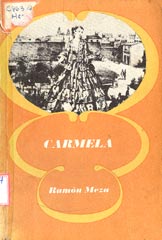3.2.7 The narrative work of Ramón Meza (1861-1911)

Ramón Meza graduated in Civil and Canon Law in 1882 and two years later published his first text in the Revista de Cuba. He also contributed to “La Lotería” and “La Habana elegante”. His narrative career includes the following pieces: “El duelo de mi vecino” (My Neighbor’s Duel), “Flores y Calabazas” (Flowers and Pumpkins) (1886), “Carmela” (1887) –this novel had won a second prize in the floral competitions sponsored by the Catalan society “Colla de Sant Mus” in 1886-, “Mi tío el vendedor” (My Uncle the Employee) (1887), “Don Aniceto the Shopkeeper” (1889) and “Ultimas Páginas” (Last Pages) (1891).
The work “Carmela” has a common background in terms of the social reality reflected in Cirilo Villaverde’s Cecilia, associated with slavery and racial prejudices that determined boundaries for individual behavior. The character who gives this title refers in terms of physical and moral characteristics to the model of Cecilia, although a greater degree of awareness regarding the established limits is appreciated between her and her beloved Joaquín.
Although the novel follows romantic norms, realism emerges in Joaquín’s reflections after his escape with Carmela. For his part, the black man Tocineta fulfills a literary function similar to that of José Dolores Pimienta in Cecilia Valdés, as he also depicts a society that, rather than divided, presented a complex gradation built on racial nuances and economic positions. However, he has a more sarcastic temperament, as he ironically observes throughout the novel how Carmela’s dreams crumble. Adding to the traditional mestizaje is the Asian character Assan, representative of a generally despised culture.
“Flores y calabazas,” according to “Historia de la Literatura Cubana,” “deals with the much-discussed theme of impossible loves and fruitless hopes, where the temptations of the urban high world contend with the candor of feelings nurtured in a natural environment.” This piece constituted the writer’s narrative dawn, where he displays an eidetic perception of nature and social realities. Implicit in the text is a certain critique of the behavior and axiological emptiness of the emerging bourgeoisie; however, the author would achieve superior achievements in other texts, especially with regard to rhythm and narrative construction.
As for “Last Pages,” it’s a work that purports to be psychological, but the connection between the situation experienced by Pablo, who narrates his memoirs, and his iterative neurotic musings seems somewhat gratuitous. The theme of incest haunts the character, associated with the memory of Natalia, his dead sister. The work offers a strange image overall, along with some realistic touches that permeate Pablo’s insanity.
“My Neighbor’s Mourning” is a parodic portrait of the stifling atmosphere that gripped Cubans after the end of the Ten Years’ War; the most trivial of themes irritated tempers, and mourning was one of the possible avenues. This is presented before its triggers are exposed, thereby diminishing the hilarity associated with absurdist literature, which is rooted in many human behaviors commonly associated with honor.








